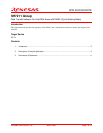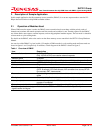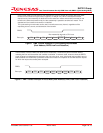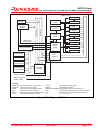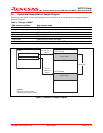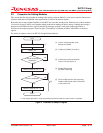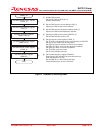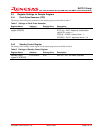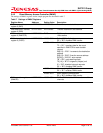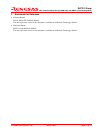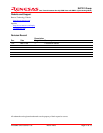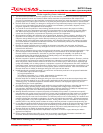
SH7211 Group
Data Transfer between On-chip RAM Areas with DMAC (Cycle-Stealing Mode)
REJ06B0732-0100/Rev.1.00 March 2008 Page 3 of 13
2. Description of Sample Application
In this sample application, the direct memory access controller (DMAC) is set to auto request mode to transfer 512-
Kbtyte data stored in the on-chip RAM to another address.
2.1 Operation of Modules Used
When a DMA transfer request is made, the DMAC starts to transfer data in accordance with the priority order of
channels and continues the transfer operation until the transfer end condition is met. Transfer requests for the DMAC
are of three kinds: auto requests, external requests, and on-chip peripheral module requests. The bus mode is selectable
as burst mode or cycle-stealing mode.
For details on the DMAC, refer to the section on the direct memory access controller in the SH7211 Group Hardware
Manual.
An overview of the DMAC is given in table 1. Examples of DMA transfer in cycle-stealing mode and burst mode are
shown in figures 1 and 2, respectively. In addition, a block diagram of the DMAC is shown in figure 3.
Table 1 Overview of DMAC
Item Description
Number of channels 8 (CH0 to CH7)
Only 4 (CH0 to CH3) can receive external requests.
Address space 4 Gbytes
Length of transfer data Byte, word (2 bytes), longword (4 bytes), and 16 bytes (longword × 4)
Maximum transfer count 16,777,216 (24 bits) transfers
Address mode Single address mode and dual address mode
Transfer request External request, on-chip peripheral module request, and auto request
(SCIF: 8 sources, IIC3: two sources, A/D converter: one source, MTU2:
five sources, CMT: two sources)
Bus mode
Cycle-stealing mode (normal mode and intermittent mode) and burst
mode
Priority level Channel priority fixed mode and round-robin mode
Interrupt request
An interrupt request to the CPU is made when half or all of a transfer
process is completed.
External request detection DREQ input low/high level detection, rising/falling edge detection
Transfer request acknowledge
signal/transfer end signal
Active levels for DACK and TEND can be set independently



